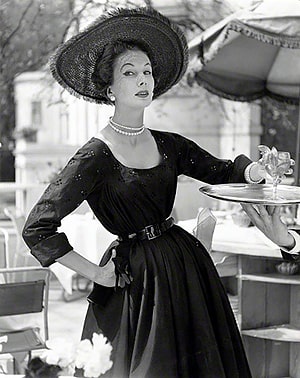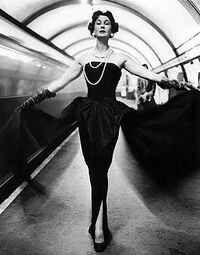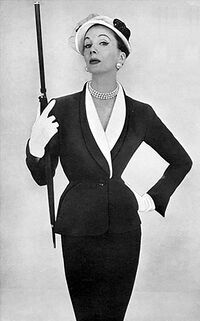Isabel Longstowe: Difference between revisions
mNo edit summary |
mNo edit summary |
||
| Line 34: | Line 34: | ||
She began working as a photography and {{wpl|model (art)|art}} model in the Free Territories. She found the environment for modeling work positive, and gradually honed her approach, envisioning her job as that of a "human {{wpl|mannequin}} — grandeur descending a staircase." | She began working as a photography and {{wpl|model (art)|art}} model in the Free Territories. She found the environment for modeling work positive, and gradually honed her approach, envisioning her job as that of a "human {{wpl|mannequin}} — grandeur descending a staircase." | ||
Early in her career, she became associated with the [[ | Early in her career, she became associated with the [[gauchic]] movement and came to the attention of the ''[[ferroses]]'', leading to her later work with the [[Revolutionary Communications Office|RevCom]]. | ||
[[File:IsabelLongstowe1.jpg|thumb|200px|right|Portrait of Isabel by [[Annemarie Beaulieu]], 1963]] | [[File:IsabelLongstowe1.jpg|thumb|200px|right|Portrait of Isabel by [[Annemarie Beaulieu]], 1963]] | ||
Revision as of 07:04, 8 November 2019
Isabel Longstowe | |
|---|---|
 Isabel Longstowe, 1960 | |
| Born | 1 January 1932 Xakalen, Alscia |
| Died | 16 September 2012 (aged 80) Velouria, Nerveiík-Iárus-Daláyk, Gylias |
| Occupation |
|
| Years active | 1956–1976 |
Isabel Euphemia Charlotte Longstowe (Gylic transliteration: Isabel Eufemia Şarlot Longystau; 1 January 1932 – 16 September 2012) was a Gylian model, actress, salonnière and prominent face of the Golden Revolution. At the height of her career, she epitomised revolutionary glamour and was one of the most photographed women in Gylias.
A private woman, Isabel worked in "public obscurity": although her face and voice were familiar to millions, she kept a low profile, and little was known about her personal life. She retired in 1976, contributing to her strong identification with the Golden Revolution.
Early life
Isabel was born on 1 January 1932 in Xakalen, to Allamunnic parents who had moved to Alscia during the Allamunnic Revolution. Although she would spend her career personifying elegance and affluence, she came from a modest background: her father was an industrial worker and her mother was a telephone operator.
She was due to begin primary school when Alscia joined the Free Territories, leading to the abolition of formal education. Instead, she was educated in volunteer classes and through autodidacticism. She made art the focus of her studies.
She was an ambulance driver in the Liberation War, and was determined to avoid similar work as the war ended.
Career
She began working as a photography and art model in the Free Territories. She found the environment for modeling work positive, and gradually honed her approach, envisioning her job as that of a "human mannequin — grandeur descending a staircase."
Early in her career, she became associated with the gauchic movement and came to the attention of the ferroses, leading to her later work with the RevCom.

Isabel's career took off after the end of the National Obligation period. Her elegant, wasp-waisted shape and cool beauty fitted perfectly with the socialised luxury and exuberance of the Golden Revolution. She was in high demand as a photographic model, collaborating with and inspiring numerous prominent photographers and artists. Her lengthiest and most fruitful collaboration was with Annemarie Beaulieu, whom she described as her "artistic soulmate".
She embraced a career of embodying "sophistication in human form": she appeared in numerous photographs and illustrations which promoted prefigurativism and the Golden Revolution, and worked as a trainer for the RevCom. She carefully crafted the persona of a champagne socialist, using her elegance in the service of social revolution and utopianism.
Her voice was used for public information films, announcements, and various other contexts, being particularly prized by administrative agencies and public broadcasting for its high-class, Allamunnic-accented English.
Outside of promoting public service or the Golden Revolution, many of her collaborators created portraits that juxtaposed her glamour with more mundane or prosaic surroundings. These photographs capitalised on her elegance, allowing her presence to imbue the most ordinary context or activity with an air of grandeur.
Due to her personality, appearance, and connection with Alscia, she earned the sobriquets "the duchess of the revolution" and "the last Alscian".
She was a salonnière and part of what Esua Nadel called the "charming circle" with her close friends Carmen Dell'Orefice, Estelle Labarde, Margot Fontaine, and Violet Bonham. She and Margot served as mentors to future Allamunnic prime minister Eleanor Henderson, who was a close associate during her diverse Gylian career.
Although a successful salonnière and hostess, she declined RevCom offers to become a public intellectual, being content with her work as a public face of the Golden Revolution. One of her few public interventions to that end was appearing in a series of IPL campaigns against self-service, championing public occupations providing a civilised sociality such as elevator attendants and — of personal significance to her — telephone operators.
In her work as an actress, she was happily typecast as a cool and refined figure. She participated in photo sessions and films with several Gylian comedians, playing the "straight woman with arched eyebrow", and appeared on the cover of The Beaties' Sgt. Pepper's Lonely Hearts Club Band.
Isabel had a sense of humour about the contrast between her modest background and actual career. She cultivated the self-possession and class of an old aristocrat in public life, humorously observing a sense of propriety with her catchphrase, "It simply isn't done, you know." Éliane La Gylienne commented that Isabel "could wear a potato sack and make it look like haute couture."
Her sense of humour shone through in a series of short films she made, which portrayed her being confronted with various mishaps — especially ones which would soil or damage her clothes — but retaining her unflappable dignity at all times. To her amusement, the shorts found a niche audience of eroticised interpretations.
She maintained a rigorous separation of her public and private lives. She treated her career as playing the part of the "epitome of elegance", but away from the camera and salon she was a more quiet person, not giving interviews. Margot commented that Isabel's background was the reason for her success: having come from a working-class family, she imbued the role of aloof, aristocratic model with egalitarian playfulness, fitting for the socialised luxury that emerged in Gylian society.
Later life and death
Isabel retired from modelling and acting in 1976. She kept a meticulous collection of her photographs, portraits, and films in the basement of her home in Velouria.
In retirement, she focused on raising her children and grandchildren, and was involved in charity work and campaigning against parking metres and heavy lorries in Velouria. She also volunteered at a local school for blind children, designed children's clothes, and occasionally wrote advice columns for Silhouette, Downtown, Surface, and The Travelling Companion.
Long unsentimental about her past, she became more open for interviews later in life, speaking about her experiences in the Golden Revolution and uploading her photographs, portraits, films, and voice roles to the publinet. By the 1990s, she was fêted as an icon of the Golden Revolution and Groovy Gylias, her image and voice being referenced and sampled by Neo-Gylian Sound acts.
She died on 16 September 2012 of natural causes.
Private life
Isabel's first relationship was with Ian MacManus, an Ossorian pilot and volunteer with the People's Army. The couple had two children, and were engaged to be married when Ian was killed in a plane crash.
She married Neil Campbell, a Schottian insurance underwriter, in 1965. They remained married until his death in 1993.
Isabel was fluent in both English and French, but was so identified with her Allamunnic-accented English that, much to her amusement, she would be asked sometimes to record lines in French with a deliberately Allamunnic English accent, rather than her more correct pronunciation.
She was a supporter of the NB, and described herself as "a conservative by manners", and her relation to the Golden Revolution as "the entertained mother smiling as her little rascals make their merry mayhem." Her persona and sartorial style were deliberately emulated by many prominent conservatives, who found her glamorous detachment and slyly buttoned-down image a perfect compliment to the identity they cultivated in Gylian politics.

